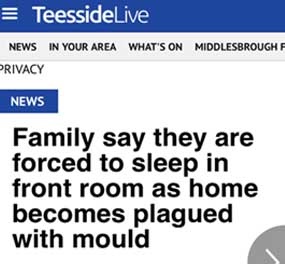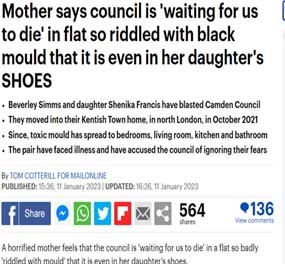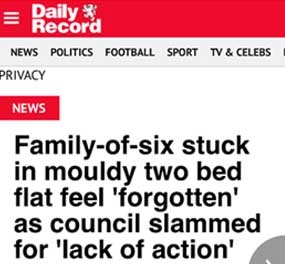Time for effective ventilation in all buildings
Towards the end of 2022, the tragic story of Awaab Ishak featured across the national media, after an inquest cited mould as the primary catalyst to the toddler’s avoidable death. Regrettably stories about damp and mould have been a constant in the media and they have undoubtedly become more frequent since the coroner’s ruling. We are now at the point where multiple news articles on separate cases is common and the images below show three separate stories, from the same day earlier this month:



Similarly to everyone who routinely assists those with dampness in social and private rental accommodation, we understand that the photographs released after the inquest are not unusual. The conditions that the Ishak family were living in are not uncommon. We are thankfully now at a point where more people realise this isn’t acceptable.
A growing issue
You have reported to us that you have seen a significant increase in calls to homes affected by dampness this winter, with problems becoming more severe and affecting larger areas. This was echoed again at the recent preservation sector open meeting, which again confirmed scenes like this are becoming more commonplace, both in private, rented and social housing. A number of factors are contributing to the rising trend, predominately linked with modern living, and the cost of fuel.
High occupancy rates as well as efforts to reduce draughts and the amount of fuel and heat used in homes have compounded and the effects of climate change and poor insulation all contribute to condensation and mould problems, while a lack of investment in planned maintenance coupled with changes to rainfall patterns and some extremely hot summers, can contribute to problems with rainwater ingress. We have frequently expressed our concerns that problems associated with damp and mould are only set to get worse - it’s the reason we have been shouting about the need for us to take the requirement for proper and adequate ventilation to be taken seriously.
Effective ventilation
One of the key elements to addressing mould issues can be the installation of appropriate and efficient ventilation. In many situations this can be the most appropriate way to resolve atmospheric moisture and air pollution problems where tenants face the challenge of mould and condensation. But lets be clear, ventilation is required for so much more then just preventing mould growth, it is also essential to control temperature, pollutants and provide us with the fresh air we need to breathe.
There’s a need for a focused approach to ventilation and air quality across the UK. This would have benefits for health and wellbeing of many, while reducing energy bills and improving the life of decoration and building fabrics. Simple strategies would make considerable in-roads in tackling the growing blight of mould and condensation for millions.
However, despite the impact that good ventilation can have on a property’s moisture levels, the current regulation and guidance setting out minimum requirements in homes is mixed and usually ignored or misunderstood. Over the years we’ve pressed for greater inclusion and enforcement of the building regulation that cover the provision of ventilation in existing buildings, it was one of the reasons the Residential Ventilation Group (RVG) was set up.
Greater accountability is needed
We are concerned about the impact and interpretation of Approved Document F, the Building Regulation that sets the minimum standard for ventilation in homes. Though recent changes now set a required standard of air exchange for existing buildings, as well as new ones, it does not get the attention it deserves. Unfortunately the standard is rarely applied where buildings are being renovated or improved - it’s exacting requirements are all too often simply ignored.
In the case of Approved Document F our focus is not really on promoting a change in its scope, rather a pragmatic, prescriptive approach to the question of “adequacy” coupled with more efforts to impose and police these mandatory requirements. Our view is that using a rigid and prescribed rate of air extraction that is based on assumed rates of occupation and background airtightness can be counterproductive.
Instead allowing specialists to design and install ventilation systems that are responsive to the needs of the occupants and considers the real airtightness and thermal performance of the building can only produce better outcomes, save energy and deliver a healthy indoor atmosphere. We would like to see more robust reporting structures, greater accountability for ventilation installers and consequences for landlords that fail to deliver buildings that are safe and dry. These aims can only come to pass if they are coupled with a culture of education and learning for all housing professionals.
Understanding the causes and implications of dampness
There’s a need for empowered, technically competent professionals who can deal with dampness, condensation and mould issues. Decisions and interventions should be based on science and understanding rather than assumption and prejudgements. We have identified this for a number of years and this is reflected back in the changes to our 'Code of Practice for the investigation and control of dampness in buildings' as well as the array of other technical documents that have been released since then, which promote best practice for surveying and installing the most common ventilation systems in existing buildings.
With more homes than ever being affected by mould, we need to do more and better – and make sure that the right outcomes are delivered quickly, efficiently and work is done right, first time, every time. Every housing officer, landlord, surveyor and building professional should have the knowledge to at least understand the causes and implications of dampness when it is seen or reported.